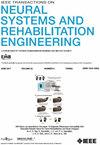HDE-Array: Development and Validation of a New Dry Electrode Array Design to Acquire HD-sEMG for Hand Position Estimation
IF 4.8
2区 医学
Q2 ENGINEERING, BIOMEDICAL
IEEE Transactions on Neural Systems and Rehabilitation Engineering
Pub Date : 2024-11-04
DOI:10.1109/TNSRE.2024.3490796
引用次数: 0
Abstract
This paper aims to introduce HDE-Array (High-Density Electrode Array), a novel dry electrode array for acquiring High-Density surface electromyography (HD-sEMG) for hand position estimation through RPC-Net (Recursive Prosthetic Control Network), a neural network defined in a previous study. We aim to demonstrate the hypothesis that the position estimates returned by RPC-Net using HD-sEMG signals acquired with HDE-Array are as accurate as those obtained from signals acquired with gel electrodes. We compared the results, in terms of precision of hand position estimation by RPC-Net, using signals acquired by traditional gel electrodes and by HDE-Array. As additional validation, we performed a variance analysis to confirm that the presence of only two rows of electrodes does not result in an excessive loss of information, and we characterized the electrode-skin impedance to assess the effects of the voltage divider effect and power line interference. Performance tests indicated that RPC-Net, used with HDE-Array, achieved comparable or superior results to those observed when used with the gel electrode setup. The dry electrodes demonstrated effective performance even with a simplified setup, highlighting potential cost and usability benefits. These results suggest improvements in the accessibility and user-friendliness of upper-limb rehabilitation devices and underscore the potential of HDE-Array and RPC-Net to revolutionize control for medical and non-medical applications.HDE-Array:开发和验证新型干电极阵列设计,以获取用于估算手部位置的 HD-sEMG。
本文旨在介绍 HDE-Array(高密度电极阵列),这是一种新型干式电极阵列,用于获取高密度表面肌电图(HD-sEMG),并通过 RPC-Net(递归假体控制网络)进行手部位置估计。我们的目的是证明一个假设,即使用 HDE-Array 获得的 HD-sEMG 信号通过 RPC-Net 返回的位置估计值与使用凝胶电极获得的信号一样准确。我们比较了 RPC-Net 使用传统凝胶电极和 HDE-Array 采集的信号进行手部位置估计的精度。作为额外的验证,我们还进行了方差分析,以确认只有两排电极不会导致过多的信息丢失,我们还对电极-皮肤阻抗进行了描述,以评估分压器效应和电源线干扰的影响。性能测试表明,RPC-Net 与 HDE-Array 配合使用,取得了与凝胶电极装置相当甚至更好的效果。干电极即使在简化设置的情况下也能显示出有效的性能,凸显了潜在的成本和可用性优势。这些结果表明,上肢康复设备的易用性和用户友好性得到了改善,并强调了 HDE-Array 和 RPC-Net 在革新医疗和非医疗应用控制方面的潜力。
本文章由计算机程序翻译,如有差异,请以英文原文为准。
求助全文
约1分钟内获得全文
求助全文
来源期刊
CiteScore
8.60
自引率
8.20%
发文量
479
审稿时长
6-12 weeks
期刊介绍:
Rehabilitative and neural aspects of biomedical engineering, including functional electrical stimulation, acoustic dynamics, human performance measurement and analysis, nerve stimulation, electromyography, motor control and stimulation; and hardware and software applications for rehabilitation engineering and assistive devices.

 求助内容:
求助内容: 应助结果提醒方式:
应助结果提醒方式:


